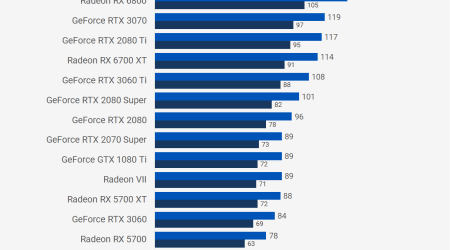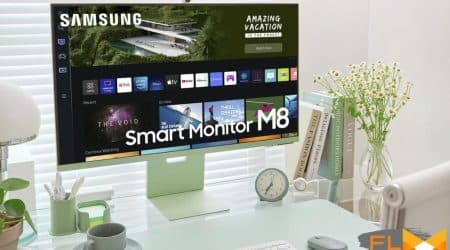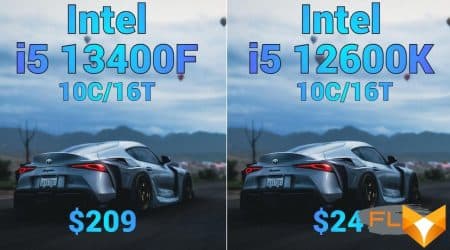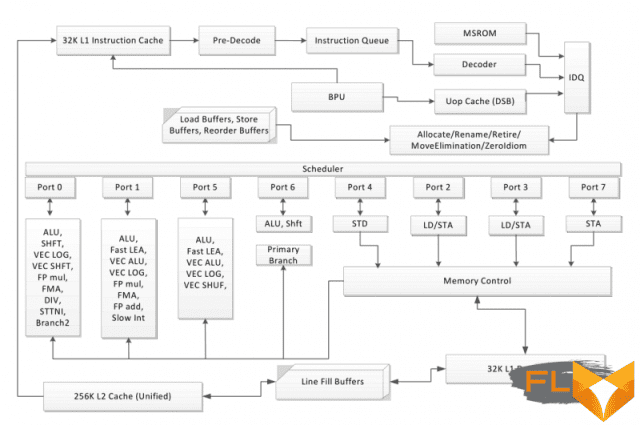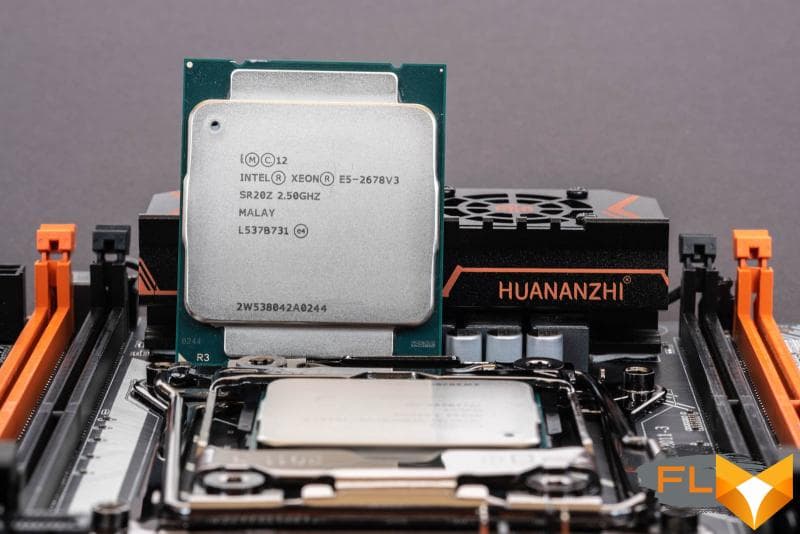


The topic of PCs assembled from components from AliExpress did not appear yesterday – China has been regularly throwing Xeon processors decommissioned from data centers onto the trading floor for quite a long time. Moreover, Chinese merchants managed to build around them not only the necessary ecosystem, but also a whole cult, which was promoted by a fairly large group of bloggers. But whatever the true motives of the Chinese sellers of Xeon-based builds with AliExpress, there is no denying the obvious fact: at first glance, these configurations look very attractive. Xeon processors, even though they were released several years ago, have a large number of computing cores and at least do not lose in this characteristic to modern desktop solutions. At the same time, at a price they are comparable to the current processors of the lower price segment, and for an unprepared buyer, this involuntarily gives the impression that ordering components from China is a good way to create productive and at the same time inexpensive PCs.
Nevertheless, until recently, we did not undertake detailed tests of old Xeons with AliExpress. Their obvious technological lag behind current CPUs, along with the problems that motherboards designed for them by Chinese manufacturers bring with them, seemed to us reason enough that the old Xeons had no chance of becoming a popular choice for a tech-savvy audience. However, the reality around us has changed a lot. The prices for components in retail are very unstable, and, in addition, the domestic computer market is threatened by a shortage of components. Whether negative scenarios are realized or not is still difficult to judge. But in order to plunge into the topic of Chinese Xeon in more detail, there are enough reasons anyway. Life may well decide that the selection and ordering of components on AliExpress will become not only one of the few possible options, but also the most preferable in terms of price when assembling new PCs. Therefore, knowing in advance what you can count on in this case will obviously not be superfluous.
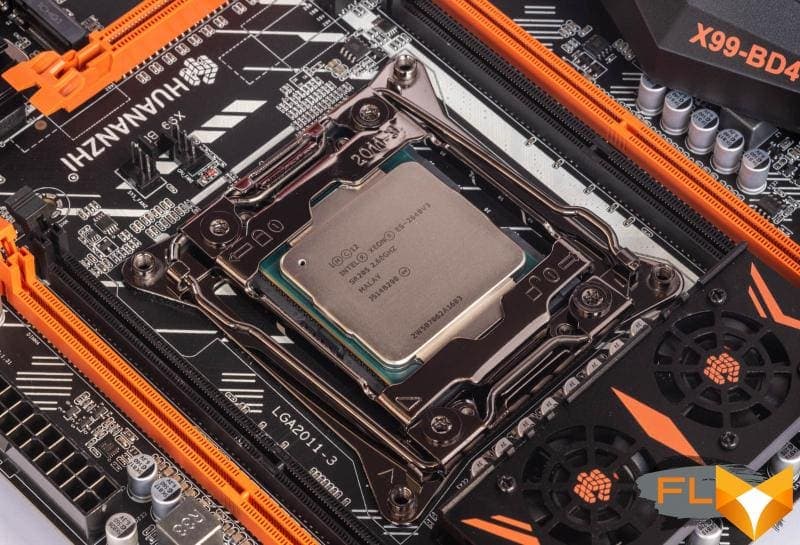
On the Chinese marketplace, you can find a wide range of used Xeons of various generations, oriented to installation in various sockets. However, in any case, all such processors are instances that have already worked out their time in servers, and therefore they are not among the modern ones. The most recent CPUs that can be found among Chinese Xeons are the Xeon E5 v3 series – they were produced in 2014-2015 and were intended for the LGA2011-3 socket. The same platform was used, for example, by the Core i7-5960X Extreme Edition HEDT processor.
It is about the LGA2011-3 platform that will be discussed in this article. Firstly, the processors for it are more modern and more productive than other options from AliExpress: they are based on the Haswell microarchitecture and already have support for DDR4 SDRAM. Secondly, this family includes a large number of different models, including those with a double-digit number of cores. And thirdly, for representatives of this family, enthusiasts have learned to enable some kind of MCE (Multi-Core Enhancements) – a function that allows you to increase the clock frequency by activating the maximum turbo mode when loading any number of cores. All this together makes the Xeon E5 v3 more attractive than the other options – it is from them that you can expect maximum performance.
For this test, we took the two most popular processors of the Xeon E5 v3 family, simply selecting them by the maximum number of purchases on AliExpress. These processors were the eight-core Xeon E5-2640 v3 with a price of about $25 and the twelve-core Xeon E5-2678 v3, which costs about $110. It is worth mentioning that there are more sophisticated, for example, eighteen-core processors on the trading floor, but they are not particularly popular due to the redundancy of such a number of cores and increased requirements for power and cooling systems. Also, a Chinese motherboard with support for Xeon E5 v3 became a direct participant in testing – its role was played by the Huahahzhi X99-BD4 Gaming model worth $95. Thus, this review will focus on the full platform that anyone can purchase on AliExpress.
⇡#What you need to know about Xeon E5 v3
The Xeon E5 v3 processors were released by Intel in the second half of 2014 and were the result of the introduction of the Haswell microarchitecture in the server segment. Formally, Haswell is the second iteration of the microarchitecture after Sandy Bridge and the first “so”, that is, its significant alteration. At the same time, users of desktop processors, when Intel offered them Haswell, were not too pleased with the improvements introduced at this stage, although the older desktop carrier of this microarchitecture, the Core i7-4770K, turned out to be faster than the flagship Sandy Bridge by quite noticeable 10-15%.
However, the server segment took the emergence of Haswell with much more optimism. And the point here is not so much in the increase in performance, but in the new opportunities that the Xeon E5 v3 processors gave server builders. Among them are support for 256-bit AVX2 vector instructions, which is important for solving computational problems, a one and a half-fold increase in the maximum number of cores, and support for the new DDR4 memory. All this in total made it possible to increase the performance and functionality of servers much more significantly than in the case of desktop systems.
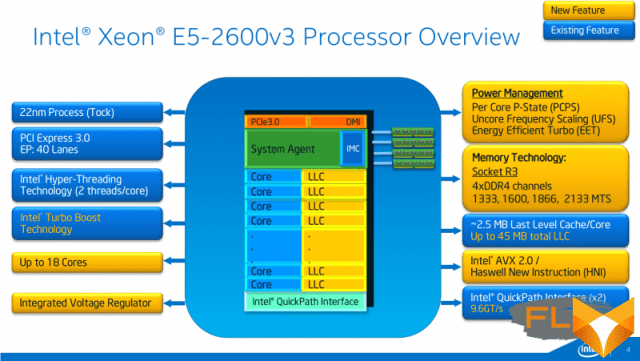
This list of changes allows the Xeon E5 v3 to offer a nice set of features on paper and in modern conditions, which is exactly what those who promote this platform among ordinary users use. Support for DDR4 makes it possible to use familiar and common memory with Xeon E5 v3 processors. AVX2 instructions are now in demand not only in server applications, but also in desktop applications. And the number of cores in the Xeon E5 v3, which can reach up to 18, gives the impression that the performance of such CPUs is sufficient for today.
However, the Xeon E5 v3 processors, which were manufactured using a 22 nm process technology, do not have very high clock speeds. According to this characteristic, they do not even outperform their predecessors. Representatives of this family are characterized by base frequencies of about 2.2-3.0 GHz and frequencies in turbo mode, reaching at best 3.4-3.8 GHz. Thermal packages of different CPU models range from 55 to 145 W, but you need to keep in mind that Haswell is hotter than other processors, at least because they have moved the power regulator from the motherboard.
Xeon E5 v3 are designed for use in motherboards with an LGA2011-3 connector, which is slightly different from that used with previous LGA2011 processors. The changes are associated with both the introduction of support for DDR4 SDRAM and the appearance of a built-in power regulator in Haswell. By the way, it was thanks to him that new frequency and voltage control technologies were added to the Xeon E5 v3 – Per Core P-State and Energy Efficient Turbo. With their help, the processor implements nuclear frequency control, which ultimately opens up the notorious possibility of “turbo boost blocking” in the Xeon E5 v3. Thanks to it, the processor can be made to work at the maximum frequency set by the turbo mode, with a load on any number of cores, and not on one or two, as the specification suggests.
In 2014, the LGA2011-3 platform was presented in two versions: a server one with the C612 system logic (codenamed Grantley) and a HEDT with the X99 chipset. Both of these chipsets provided support for USB 3.0 and SATA3 ports, as well as a gigabit network, while the processors themselves were responsible for the operation of the PCI Express 3.0 bus in the LGA2011-3 platform – the controller built into the Xeon E5 v3 supports as many as 40 PCIe lanes. However, both C612 and X99 are relatively expensive and are no longer produced by Intel, therefore, in the modern Chinese edition of the LGA2011-3 platform, completely different chipsets are used more often. Fortunately, Xeon E5 v3 uses a standard DMI 2.0 bus to communicate with the system logic, to which a fairly wide range of Intel chipsets can be connected. As a result, there are LGA2011-3 boards on AliExpress based on B85, H81, Q85, Z87 and other simple chipsets that were usually used in LGA1150 desktop boards.
However, this practically does not affect the functionality of the platform. The main set of its properties is implemented in the processor itself. All PCIe lanes are taken directly from the CPU, and memory support also depends on the processor itself – in any configuration, the LGA2011-3 platform supports four DDR4-1866 or DDR4-2133 channels in the form of registered or regular unbuffered DIMMs. The only thing to keep in mind is that some Chinese manufacturers, for reasons of economy, do not always distribute all four memory channels on motherboards, limiting themselves to supporting dual-channel DDR4 SDRAM. Also among the inexpensive offers are motherboards for DDR3 memory, some Xeon E5 v3 models are also compatible with it.
⇡#Can Haswell be considered a modern microarchitecture
At first glance, it seems that Haswell is a very relevant microarchitecture, which, although it was developed almost a decade ago, has not yet become obsolete. Continuing this logic, we can say that modern Alder Lake has nothing that would claim the title of a killer feature that determines their fundamental superiority. So, support for AVX-512 in the desktop versions of modern CPUs is disabled, and the hybrid design and Thread Director technology still remain the prerogatives of exclusively flagship models and, moreover, are fully supported only in Windows 11.
At the same time, Haswell is seriously different for the better from its progenitor, the Sandy Bridge microarchitecture. And this is not only about the already mentioned support for AVX2 instructions, but about more fundamental changes that have been made at the lowest level. Haswell improved branch prediction algorithms and improved error handling in branch prediction; extended all the main intra-kernel buffers (primarily out-of-order execution buffer); increased – from 6 to 8 – the number of executive ports; and also doubled the performance of data save and load operations, as well as the bandwidth of the second-level cache.
Haswell microarchitecture
However, given the array of improvements Intel has made since Haswell’s inception, the idea of Haswell being progressive in any way seems like a bit of an overstatement. And although in the desktop segment, Intel suspended the development of CPU designs for almost six years, in the time that has passed since the advent of Haswell, the company still managed to take three serious steps forward. These steps are Skylake, Cypress Cove and Golden Cove.
As a result, if we compare Haswell and Golden Cove cores, there is no doubt about the overwhelming advantage of today’s microarchitecture. It is visible at every stage of the execution pipeline. If we talk about its input part, then Golden Cove is twice as fast as Haswell in terms of fetching instructions from the L1 cache, it has one and a half times more decoders and has a cache of decoded instructions for 4096, and not 1536 micro-operations, which is also capable of giving them with twice as fast. To this we must add serious improvements in branch prediction – a significant increase in the buffer of branch targets and the appearance of AI elements in its algorithms.
A significant expansion of the input part of the execution pipeline finds a symmetrical response at subsequent stages. Golden Cove, in comparison with Haswell, is capable of sending one and a half times more instructions for execution, for the processing of which 12 execution ports are now provided against eight available in Haswell. At the same time, the reordering buffer, within which instructions can be sent for execution out of program order, has grown in volume by 2.7 times. All this significantly expands the Golden Cove microarchitecture throughout the execution pipeline and ultimately makes cores based on it much more computationally productive.
It should also be noted here that Haswell is seriously inferior to modern processors in terms of data processing capabilities. The Golden Cove microarchitecture is capable of performing three 256-bit data downloads per clock, while Haswell is designed for only two such downloads. In addition, the new processors have significantly increased the amount of cache memory. Instead of 32KB L1D and 256KB L2 cache, Golden Cove cores use 48KB L1D and 1280KB L2 caches.
Thus, almost any of the key nodes of the processor microarchitecture has become wider, faster or more efficient by at least one and a half times over the past nine years since the advent of Haswell. And this means that in terms of IPC (the number of instructions executed per clock), Haswell should be quite significantly behind modern processors of the Alder Lake generation. To quantify this gap, we ran a small test comparing the performance of the Haswell and Alder Lake families with the same number of cores and at the same clock speed.
For the purity of the experiment, in this case, two desktop quad-core processors Core i7-4770K (Haswell) and Core i3-12100 (Alder Lake) were used with a clock speed rigidly fixed at around 4.0 GHz.
And in such a comparison in resource-intensive applications, Alder Lake showed an approximately one and a half times advantage over Haswell, which is in perfect agreement with the scale of microarchitecture improvements described above on the Haswell – Skylake – Cypress Cove – Sunny Cove evolutionary path.
| Haswell 4C 4.0GHz | Alder Lake 4C 4.0GHz | Benefit | |
|---|---|---|---|
| 7-zip 21.02 seconds | 322.6 | 244.5 | 31.9% |
| Lightroom Classic 10.3 seconds | 438.6 | 238.7 | 83.7% |
| Premiere Pro 2021, seconds | 487.1 | 337 | 44.5% |
| Topaz Video Enhance AI 2.3, fps | 0.71 | 0.8 | 12.7% |
| x265 (3.5), fps | 5.53 | 8.82 | 59.5% |
| Stockfish 14.1, kNodes/s | 5428 | 8396 | 54.7% |
| Blender 2.93 seconds | 588.2 | 403 | 46.0% |
| Average | 47.6% |
The situation is even clearer in games. In the case of measuring the frame rate with the GeForce RTX 3090 graphics card, when choosing the maximum quality in Full HD resolution, the superiority of Alder Lake in terms of specific performance is even slightly higher than in resource-intensive applications.
| Haswell 4С 4,0 GHz | Alder Lake 4C 4.0GHz | Benefit | |
|---|---|---|---|
| Civilization VI: Gathering Storm | 90.3 | 120.3 | 33.2% |
| Cyberpunk 2077 | 68.7 | 97.3 | 41.6% |
| Hitman 3 | 64.9 | 109.2 | 68.3% |
| Serious Sam: Siberian Mayhem | 81.5 | 107.7 | 32.1% |
| Shadow of the Tomb Raider | 128.4 | 185.3 | 44.3% |
| The Riftbreaker | 78.5 | 142.1 | 81.0% |
| Watch Dogs Legion | 58.5 | 93.1 | 59.1% |
| Average | 51.4% |
And this means that processors with Haswell microarchitecture lag behind modern solutions in terms of specific performance by at least one and a half times. This is a very convincing illustration of the fact that, no matter how much the adherents of Xeon with AliExpress would like, they have no right to be considered modern solutions.
Moreover, in reality, the performance gap between the Xeon E5 v3 and the current generation of Intel processors will be even more dramatic, because in addition to IPC there is also a noticeable difference in clock speeds. Haswell was built on a 22nm process that maxed out at 4.0GHz, and now much more modern 10nm technology is in use, allowing Alder Lake multi-core processors to storm the 5GHz mark. At the same time, the frequency of multi-core representatives of the Xeon E5 v3 series, even in the case of “turbo boost blocking”, will most likely lie in the region of 3.4 GHz, while any of the Alder Lake desktops, even at the entry level, will provide an operating frequency of at least 4.0 GHz. This difference in frequency translates into an additional performance gap for Xeon E5 v3 family solutions, the relative size of which will be proportional to the difference in frequency and will be at least 20-25%.
And this means that the gap in the potential performance of Xeon E5 v3 and Alder Lake with the same number of cores, according to approximate estimates, will be close to twofold. Therefore, buyers of server processors on AliExpress should be aware that when purchasing an eight-core processor, they will at best get something at the level of Core i3, and to get performance similar to that of Core i5, you need to look towards Xeon with at least 12 cores. Moreover, solutions with Haswell microarchitecture can be compared with inexpensive modern processors only in terms of multi-threaded performance, and in the case of low-threaded loads, their competitiveness in comparison with any modern solutions is very doubtful.
⇡#Xeon E5-2640 v3 and Xeon E5-2678 v3 features and specifications
A very large number of different CPUs were released in the Xeon E5 v3 series, but in general, all this diversity comes down to differences in the number of computing cores and the installed thermal package. For ordinary users who are interested in building a general purpose PC, models with a higher frequency are primarily of interest, and these are not older models. The Xeon E5-2640 v3 and Xeon E5-2678 v3 chosen by us for tests are popular for a reason: these are just such options that, on the one hand, have acceptable frequencies, and on the other, can boast an attractive price.
The Xeon E5-2640 v3 is an octa-core CPU that can safely be called ultra-budget. There are simply no modern processors that would cost a couple of tens of dollars, and from this position, the Xeon E5-2640 v3 is unique in its kind.

The base frequency of this CPU is 2.6 GHz, in turbo mode under low-thread load it can be overclocked to 3.4 GHz. This frequency from the Xeon E5-2640 v3 can be obtained under any load, if you apply a special hack to it – the so-called turbo boost blocking. It is implemented by fixing the BIOS code, and on the Web you can find both step-by-step instructions for its implementation, as well as ready-made patched firmware for various Chinese motherboards.
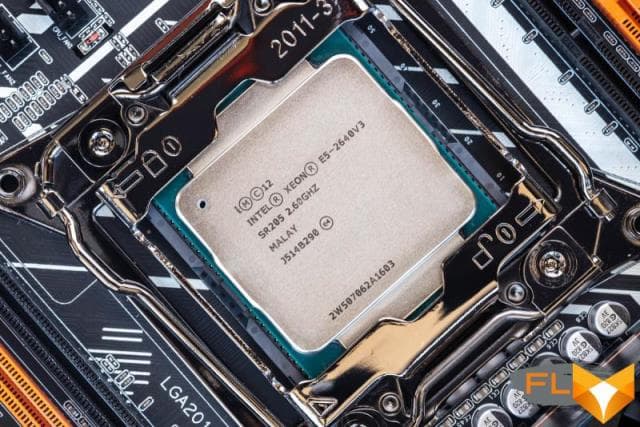
The amount of cache memory of the third level of the considered eight-core is 20 MB. Its memory controller supports quad-channel DDR4-1866 – faster memory, unfortunately, does not work with the Xeon E5-2640 v3.
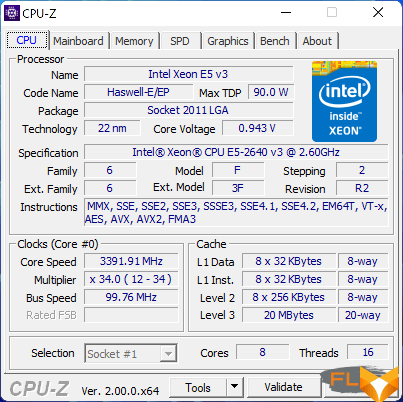
The thermal package of the Xeon E5-2640 v3 is set to 90 W, while the processor does not heat up very much, and it is not difficult to remove heat from it thanks to a rather large crystal with an area of 366 mm2 and solder under the cover. Even with a frequency fixed at 3.4 GHz, this processor is comparable in terms of consumption and heat dissipation to modern Ryzen 5 5600X and does not require any complex cooling systems.
The second processor, the 12-core Xeon E5-2678 v3, is on the other end of Haswell’s server lineup, according to Chinese sellers. It is among the “elite” offers on AliExpress – they will ask for about the same as for the new Core i3-12100F. This, of course, is far from a true premium level, but there are simply no more expensive used Xeon E5 v3 options. Even 18-core processors cost about the same. This positioning of the 12-core processor is due to its characteristics: an interesting number of cores, a good clock frequency, and acceptable heat dissipation are brought together here.
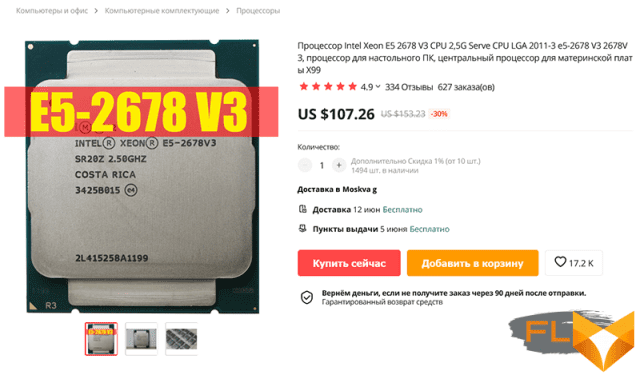
The base frequency of the 12-core Xeon E5-2678 v3 is 2.5 GHz, and in turbo mode it rises to 3.3 GHz. In nominal value, the maximum frequency is available only with a load of 1-2 cores, but the processor can be configured in such a way (by fixing the BIOS) that it will always work on it.
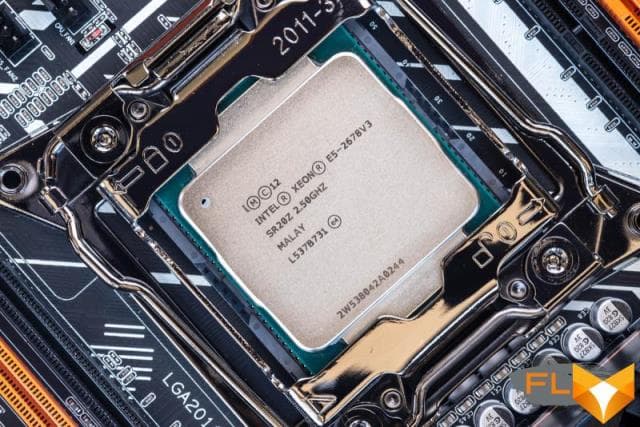
The volume of L3-cache in a 12-core one and a half times more than in an eight-core one, and reaches 30 MB. At the same time, the cache itself is arranged a little differently than in the Xeon E5-2640 v3: in this case, the cache segments are connected not by one, but by two ring buses with intermediate switches. For this reason, parts of the L3 cache in relation to one core have slightly different latency. The situation is similar with memory controllers – in this case, two dual-channel controllers with support for DDR4-2133 are used, and not one four-channel controller, as in the case of the Xeon E5-2640 v3.

Unlike its eight-core counterpart, the Xeon E5-2678 v3 is a pretty hot chip. Officially, its TDP is 120W, and in real operation, it can heat up approximately like 12-core Alder Lake. For such a processor, a rather serious cooler is already needed.
Separately, it should be mentioned that the Xeon E5 v3 processors, due to their server purpose, are deprived of any overclocking capabilities. Their multiplier is locked, so neither the Xeon E5-2640 v3 nor the Xeon E5-2678 v3 can operate at frequencies above 3.3-3.4 GHz. In the same way, these processors do not allow overclocking the memory either: DDR4-1866/2133 is the maximum possible. And although the low frequency of memory in systems based on Xeon E5 v3 is partly offset by its four-channel, in such configurations it is better to use at least unbuffered modules, which are faster than register ones. We discuss this point separately, since sellers on AliExpress often offer kits that include slower server register memory.
⇡#Notes about Chinese LGA2011-3 boards
Since the Xeon E5 v3 processors are intended for use as part of server equipment, they did not initially make “civilian” motherboards for them. The only exceptions are motherboards based on the X99 chipset for HEDT processors of the Core i7-5900X series, which are also compatible with server CPUs, but they were released relatively few, and now it is unrealistic to find them on sale. Therefore, Chinese manufacturers had to tackle this problem, and AliExpress was flooded with a fairly large number of consumer LGA2011-3 boards produced under local brands like Huananzhi, Jingsha, Machinist and others.
All of these boards are designed specifically for building desktop PCs based on the Xeon E5 v3, so they are endowed with such characteristics that the average user gets from the system on a server processor about the same feeling as from a regular desktop. That is why Chinese boards for Xeon E5 v3 have nothing in common with server motherboards and are much more similar to modern boards for Socket AM4 or LGA1700 processors. The characteristics of the Xeon E5 v3 themselves help a lot: the processor has 40 PCIe 3.0 lanes, and this set is quite enough not only to connect a video card, but also to implement M.2 slots, as well as to connect any kind of controllers. In other words, despite the fact that LGA2011-3 chipsets were designed many years ago, the capabilities of Chinese boards based on them do not look archaic at all.
However, there is a problem of a different nature: Chinese board manufacturers are prone to excessive savings, and this can be seen in general in everything. As a result, although the LGA2011-3 boards from AliExpress offer everything you need for a modern system, the controllers installed on them (for example, network or sound) are likely to be selected from among the cheapest. USB 3.0 ports are also likely to be few, and all of them will most likely lack ESD protection.

A specific example is the Huahahzhi X99-BD4 Gaming board, which we used in this test. Judging by the price, it belongs to the mid-range solutions, but with a detailed acquaintance with its design, many questions arise. So, its size is smaller than the standard ATX, which is why it is not so easy to securely fix it in the case. And the processor power circuit has only six phases and gets very hot, which is why the Chinese had to pile active cooling on it with a pair of 30 mm fans.
Naturally, such boards do not provide for any backlighting, as well as the possibility of connecting it, and fan speed control is available only for one processor cooler.
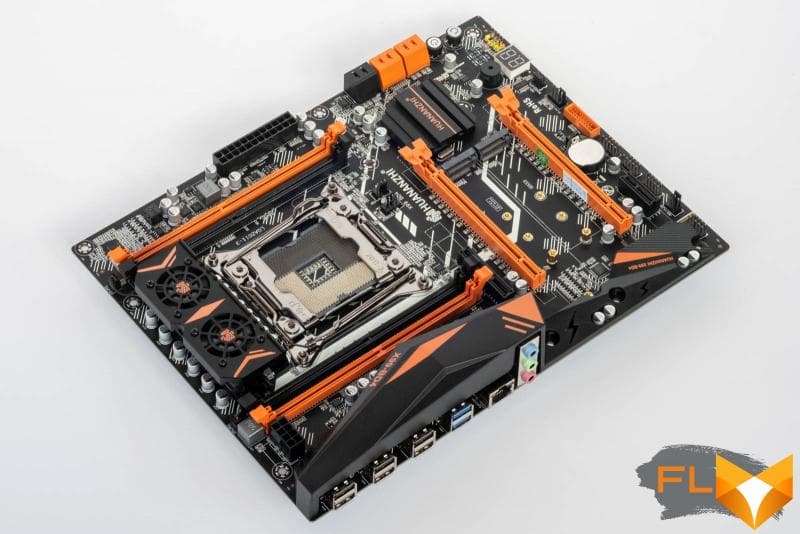
But even more frustrating is the BIOS of Chinese LGA2011-3 boards. No one is engaged in any adaptation for desktop systems, and in fact the user has to deal with a set of settings specific to servers, where everything is very, very specific. For example, such a BIOS does not provide for the possibility of changing memory timings, and in order to gain access to these settings, it is necessary to change the firmware to a special modified version. The same goes for the notorious “turbo boost lock” feature. To get the Xeon E5 v3 to run at maximum frequency, you also need to modify the BIOS code.
In addition, in the process of using Chinese boards, a lot of small, but rather unpleasant glitches pop up, which are far from always being successfully dealt with. Discussions of such motherboards on the forums invariably stretch for hundreds of pages, which perfectly shows that you can’t expect an easy life with them.
⇡#Description of the test system and testing methodology
According to preliminary estimates, Xeon E5 v3, at best, can compete only with inexpensive modern processors. Therefore, in comparison with them, we included four- and six-core representatives of the Alder Lake and Zen 3 families, belonging to the Core i3, Core i5 and Ryzen 5 series.
The following components were used in the test systems:
- Processors:
- AMD Ryzen 5 5600X (Vermeer, 6 cores + SMT, 3.7-4.6GHz, 32MB L3);
- AMD Ryzen 5 5600G (Cezanne, 6 cores + SMT, 3.9-4.4GHz, 16MB L3);
- Intel Core i5-12600 (Alder Lake, 6P-core + HT, 3.3-4.8GHz, 18MB L3);
- Intel Core i5-12400 (Alder Lake, 6P cores + HT, 2.5-4.4GHz, 18MB L3);
- Intel Core i3-12300 (Alder Lake, 4P cores + HT, 3.5-4.4GHz, 12MB L3);
- Intel Core i3-12100 (Alder Lake, 4P cores + HT, 3.3-4.3GHz, 12MB L3);
- Intel Xeon E5-2678 v3 (Haswell-EP, 12 cores + HT, 2.5-3.3GHz, 30MB L3);
- Intel Xeon E5-2640 v3 (Haswell-EP, 8 cores + HT, 2.6-3.4GHz, 20MB L3).
- CPU cooler: Noctua NH-D15S.
- Motherboards:
- ASUS ROG Strix X570-E Gaming WiFi (Socket AM4, AMD X570);
- ASUS ROG Strix Z690-F Gaming WiFi (LGA1700, Intel Z690);
- Huahahzhi X99-BD4 Gaming (LGA2011-3, Intel B85).
- Memory:
- 4×16GB DDR4-3600 SDRAM, 16-18-18-38 (Crucial Ballistix RGB BL2K16G36C16U4BL);
- 2x16GB DDR5-6000 SDRAM, 38-38-38-76 (G.Skill Trident Z5 RGB F5-6000U4040E16GX2-TZ5RK).
- Video Card: NVIDIA GeForce RTX 3090 Founders Edition (GA102, 1395-1695/19500MHz, 24GB GDDR6X 384-bit).
- Disk subsystem: Intel SSD 760p 2TB (SSDPEKKW020T8X1).
- Power supply: Thermaltake Toughpower DPS G RGB 1000W Titanium (80 Plus Titanium, 1000W).
Representatives of the Xeon E5 v3 series were tested in the most productive version – at the maximum frequency using “turbo boost blocking” and with four-channel unbuffered memory with reduced timings. So the octa-core Xeon E5-2640 v3 was clocked at 3.4GHz with DDR4-1866 with 9-10-10-30-1T latency, while the 12-core Xeon E5-2678 v3 was clocked at 3.3 GHz, and the memory used with it worked in DDR4-2133 mode with timings of 10-11-11-32-1T.
The rest of the processors were also tested with the canceled artificial consumption restrictions. This means that the PPT limits (for the Socket AM4 platform) and PL1/PL2 (for the LGA1700 platform) were ignored, instead the maximum possible frequencies were used in order to obtain the best performance.
The tests were performed on a system with the fastest GeForce RTX 3090 graphics card so that the performance of the graphics subsystem did not limit the performance of the compared processors from above and the results obtained in gaming applications illustrated the maximum capabilities of the CPU, and nothing else.
Testing was performed on the Microsoft Windows 11 Pro (21H2) Build 22000.282.0 operating system with KB5005635 and KB5006746 updates installed and using the following driver set:
- AMD Chipset Driver 4.03.03.431;
- Intel Chipset Driver 10.1.18838.8284;
- Intel SerialIO Driver 30.100.2105.7;
- Intel Management Engine Interface 2124.100.0.1096;
- NVIDIA GeForce 512.16 Driver.
Description of the tools used to measure computing performance:
Comprehensive benchmarks:
- Futuremark PCMark 10 Professional Edition 2.1.2508 – testing in Essentials scenarios (typical work of the average user: launching applications, surfing the Internet, video conferencing), Productivity (office work with a word processor and spreadsheets), Digital Content Creation (creating a digital content: photo editing, non-linear video editing, rendering and visualization of 3D models).
- 3DMark Professional Edition 2.22.7336 – testing in the CPU Profile 1.1 scenario with eight active threads and at the maximum possible processor load.
Applications:
- 7-zip 21.02 – archiving speed testing. The time taken by the archiver to compress a directory with various files with a total volume of 3.1 GB is measured. Uses LZMA2 algorithm and maximum compression ratio.
- Adobe Photoshop 2021 22.4.3 – Graphics performance testing. The average execution time of the Puget Systems Adobe Photoshop CC Benchmark 18.10 test script, which simulates the typical processing of an image taken by a digital camera, is measured.
- Adobe Photoshop Lightroom Classic 10.3 – Performance test for batch processing of a series of RAW images. The test scenario includes post-processing and export to JPEG at a resolution of 1920 × 1080 and a maximum quality of two hundred 16-megapixel RAW images taken with a Fujifilm X-T1 digital camera.
- Adobe Premiere Pro 2021 15.4.0 – performance testing for non-linear video editing. This measures the rendering time to YouTube 4K for a project containing HDV 2160p30 footage with various effects applied.
- Blender 2.93.5 – testing the speed of the final rendering in one of the popular free packages for creating three-dimensional graphics. The duration of building the final model pavillon_barcelona_v1.2 from Blender Benchmark is measured.
- Mathworks Matlab R2021b (9.11.0) – testing the speed of engineering and mathematical calculations in a popular mathematical package. A standard benchmark is used, which includes matrix and vector operations, the solution of differential and symmetric sparse linear systems of equations, as well as the construction of 2D and 3D plots.
- Microsoft Visual Studio 2017 (15.9.40) – compile time measurement of a large MSVC project – a professional package for creating 3D graphics Blender version 2.79b.
- Stockfish 14.1 – testing the speed of the popular chess engine. The speed of enumeration of options in the position “1q6/1r2k1p1/4pp1p/1P1b1P2/3Q4/7P/4B1P1/2R3K1 w” is measured.
- SVT-AV1 v0.8.6 – testing the speed of video transcoding to the promising AV1 format. Performance is measured using a raw 1080p@50FPS AVC video file with a bitrate of about 30 Mbps.
- Topaz Video Enhance AI v2.3.0 – performance testing in an AI-based program to improve video detail. The test uses the original video at 640×360 resolution, which is doubled using the Artemis Anti Aliasing v9 model.
- V-Ray 5.00 – Benchmark the performance of a popular rendering system using the standard V-Ray Benchmark Next application.
- x265 3.5+8 10bpp – testing the speed of video transcoding to H.265/HEVC format. To evaluate performance, we use the original 2160p@24FPS AVC video file with a bitrate of about 42 Mbps.
Games:
- Chernobylite. Resolution 1920 × 1080: Graphics Quality = Ultra.
- Civilization VI: Gathering Storm. Resolution 1920×1080: DirectX 12, MSAA=4x, Performance Impact=Ultra, Memory Impact=Ultra.
- Cyberpunk 2077. 1920×1080 resolution: Quick Preset = Ray Tracing – Ultra.
- Far Cry 6. 1920 × 1080 resolution: Graphics Quality = Ultra, HD Textures = On, Anti-Aliasing = TAA.
- Hitman 3. 1920 × 1080 resolution: Super Sampling = 1.0, Level of Detail = Ultra, Texture Quality = High, Texture Filter = Anisotropic 16x, SSAO = Ultra, Shadow Quality = Ultra, Mirrors Reflection Quality = High, SSR Quality = High, Variable Rate Shading = Quality.
- Horizon Zero Dawn. Resolution 1920 × 1080: Preset = Ultimate Quality.
- Marvel’s Guardians of the Galaxy. Resolution 1920 × 1080: Graphics Preset = Ultra.
- Serious Sam: Siberian Mayhem. Resolution 1920 × 1080: Direct3D 11, CPU Speed = Ultra, GPU Speed = Ultra, GPU Memory = Ultra.
- Shadow of the Tomb Raider. Resolution 1920 × 1080: DirectX12, Preset = Highest, Anti-Aliasing = TAA.
- The Riftbreaker. Resolution 1920 × 1080: DirectX12, Texture Quality = High, Raytraced soft shadows = On, Ray traced shadow quality = Ultra, Raytraced ambient occlusion = On.
- A Total War Saga: Troy. Resolution 1920 × 1080: DirectX 12, Quality = Ultra, Unit Size = Extreme.
- Watch Dogs Legion. Resolution 1920 × 1080: DirectX 12, Quality = Ultra, RTX = Off, DLSS = Off.
In all gaming tests, the results are the average number of frames per second, as well as the 0.01-quantile (first percentile) for FPS values. The use of the 0.01-quantile instead of the minimum FPS is due to the desire to clean up the results from random bursts of performance that were provoked by reasons not directly related to the operation of the main components of the platform.
⇡#Performance in complex benchmarks
It immediately turns out that the speed of work in ordinary user applications is the weak point of the Xeon E5 v3. In such loads, single-threaded performance is important, that is, high IPC and clock speed, and server processors in 2014 cannot boast of anything like that. Therefore, in the PCMark 10 test, which reproduces familiar everyday work scenarios, the performance of the Xeon E5-2640 v3 and Xeon E5-2678 v3 is completely unimpressive. They are significantly inferior to the younger Core i3 of the Alder Lake series, which has only four, but modern cores. In the Productivity and Essential office scenarios, representatives of the Xeon E5 v3 family are up to 33% slower than the Core i3-12100, and in the Digital Content Creation scenario, which simulates simple work with digital content, this lag is 14-18%.
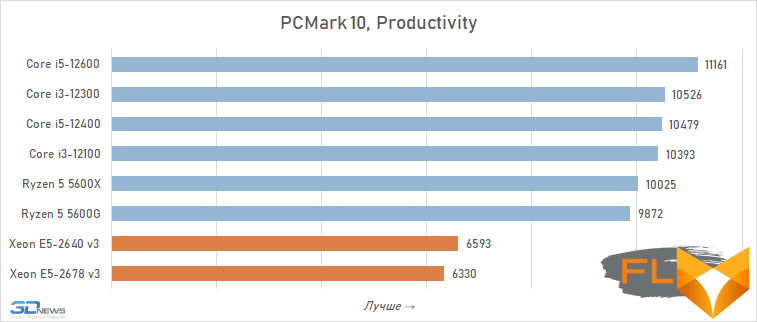

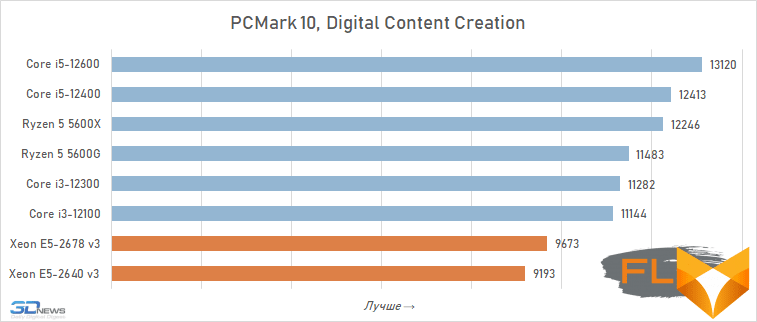
In other words, the first comprehensive test shows that the estimates obtained earlier were absolutely correct: the Haswell microarchitecture underlying the Xeon E5 v3 is difficult to compete with modern Golden Cove and Zen 3 cores. Server processors from AliExpress can only be competitive due to the number of cores and only in those tasks that allow efficient parallelization into a large number of computational threads. And such tasks are almost not included in the number of commonly used ones.
At the same time, full load parallelization can be seen in the 3DMark CPU Profile synthetic test. It simulates a certain reference game environment (the physical environment and the actions of abstract non-game characters) using the multi-threaded capabilities of processors. The diagrams below show two results: with an eight-thread load, which is typical for most modern DirectX 12 games, and with full parallelism, when the test tries to load all the cores available in the processor as much as possible.

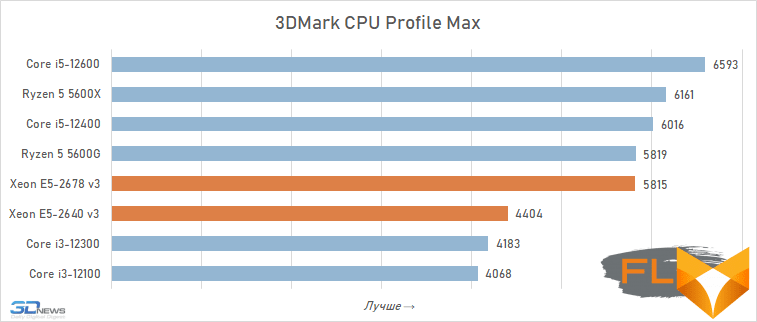
In the first case, the results of both Xeon E5 v3 look absolutely unconvincing: they lag behind modern processors by more than one and a half times, which casts doubt on the advisability of using old server CPUs at the heart of gaming systems. But in the test using the maximum number of threads, we see for the first time that the Xeon E5-2640 v3 and Xeon E5-2678 v3 are not in the last places on the diagram. However, their results still look pale: the eight-core Xeon E5-2640 v3 only slightly outperforms the four-core Alder Lake, and the 12-core Xeon E5-2678 v3 fails to overtake any modern six-core AMD or Intel.
⇡#Performance in Applications
Trying to find those real tasks where the Xeon E5 v3 can still compete with modern CPUs, we tested 12 heterogeneous applications. And in general, the result is rather disappointing. Even when it comes to resource-intensive workloads, the eight-core Xeon E5-2640 v3 is at best only marginally faster than the quad-core Core i3, and the 12-core Xeon E5-2678 v3 almost never outperforms any six-core processor with a modern microarchitecture.
This situation is observed even when rendering and transcoding video loads, where the number of cores plays an almost decisive role. Thus, we can only state that significant progress has been made in processor performance over the past few years, and those server solutions that eight years ago were at the forefront of the industry and cost over $1,000 today look like helpless budget products.
Rendering:

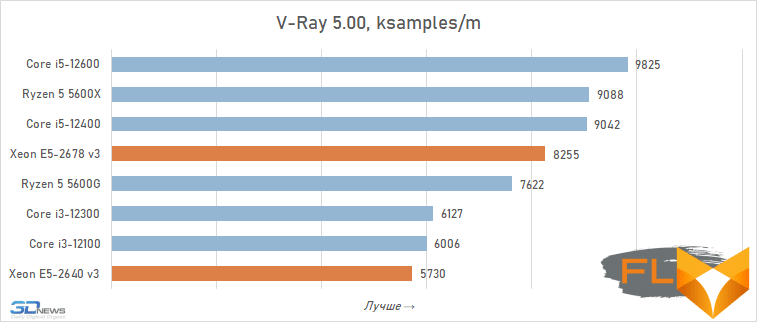
Photo processing:
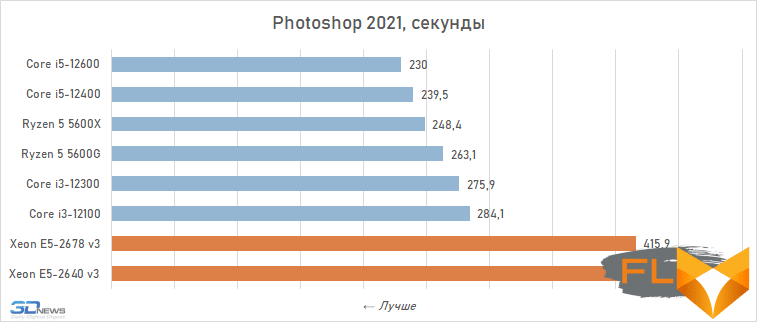
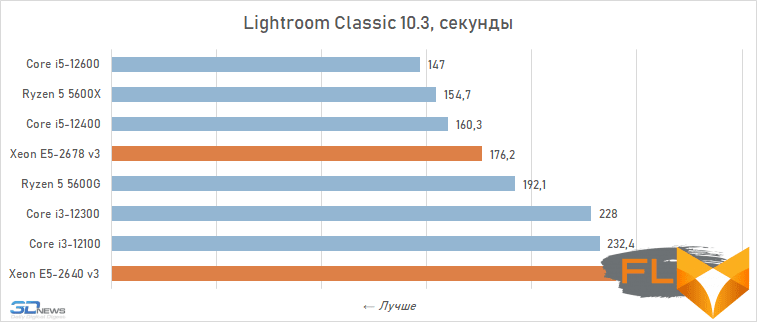
Video work:
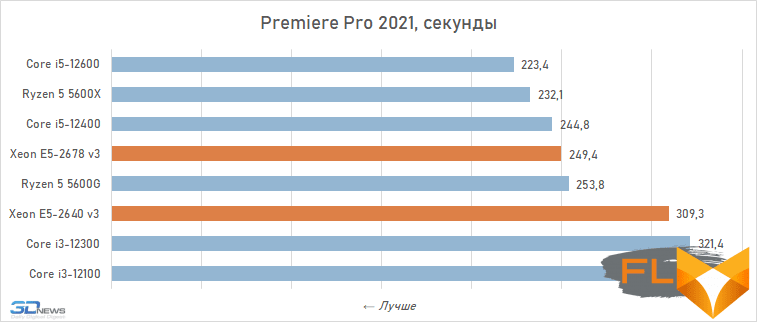
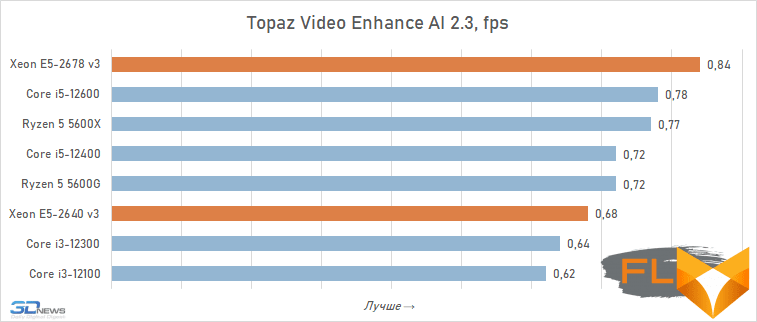
Video transcoding:
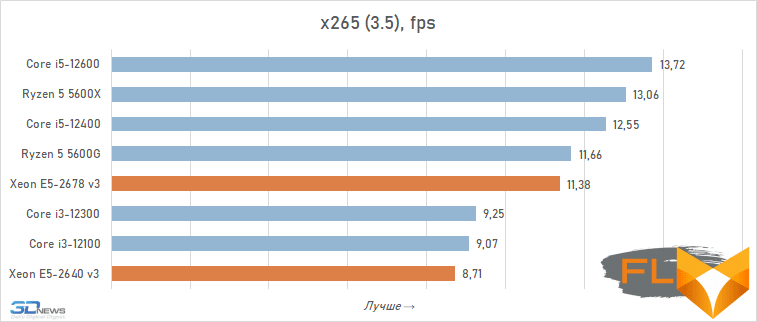
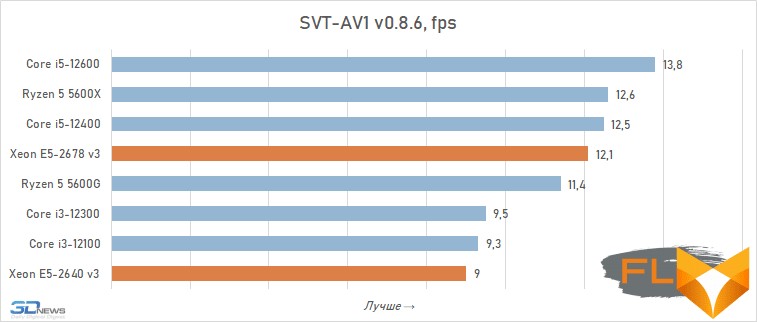
Compilation:
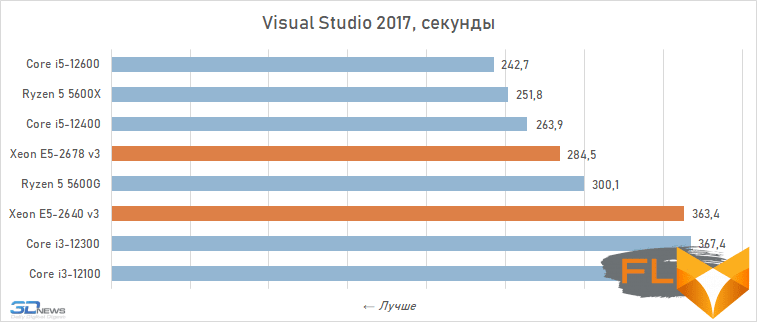
Archiving:
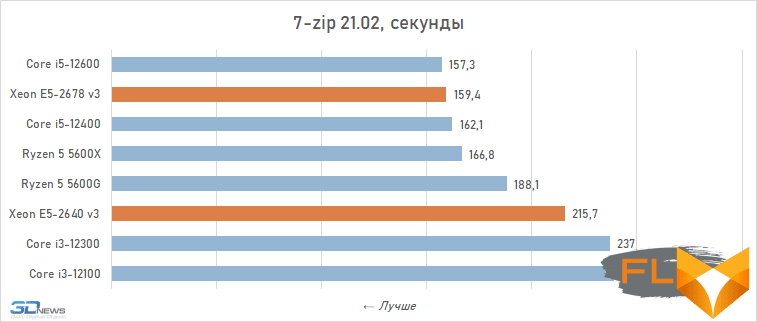
Chess:
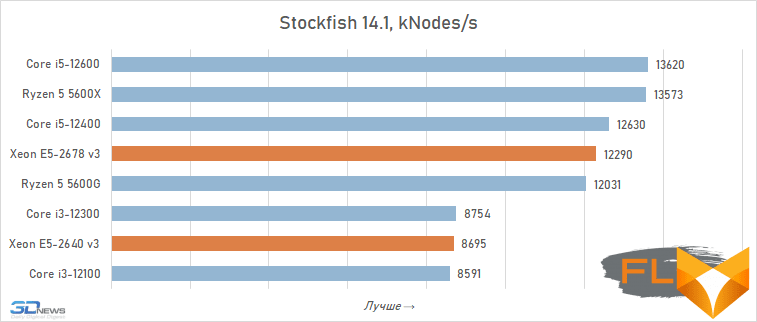
Mathematical calculations:
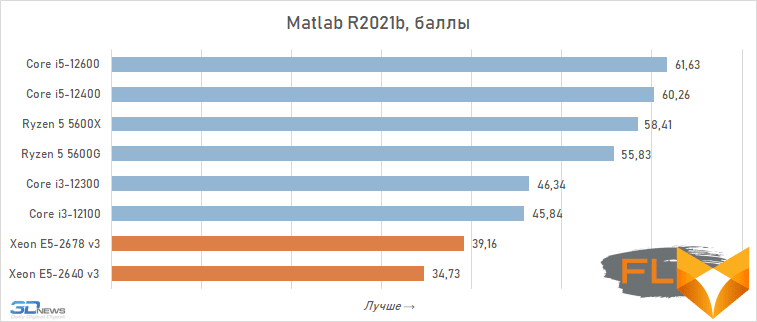
⇡#Game performance
However, against the background of gaming performance, the results of Xeon E5 v3 in applications do not look so bad at all – in games, all the weak points of these processors appear much more clearly. Low specific performance and insufficient clock speed make the Xeon E5 v3 a very unfortunate choice for gaming systems. And neither a large number of cores, nor a capacious L3 cache, nor quad-channel memory allow AliExpress processors to compete with at least the younger quad-core Alder Lake generation.
According to the average frame rate calculated for 12 games, the Xeon E5-2640 v3 lags behind the $ 100 Core i3-12100 by 23%. And the more powerful Xeon E5-2678 v3 is 17% behind the same modern quad-core. What’s more, the typical desktop six-core processors that AMD and Intel are currently making can offer at least a third better gaming performance. In other words, building gaming systems based on the Xeon E5 v3 is a bad idea.

Separately, it should be noted that only one game from our test set was able to get closer in performance to modern Xeon E5 v3 solutions. Even in cases where performance clearly scales with increasing core counts, 8- and 12-core server processors from eight years ago are miserably outperformed by low-cost desktop solutions of current generations.

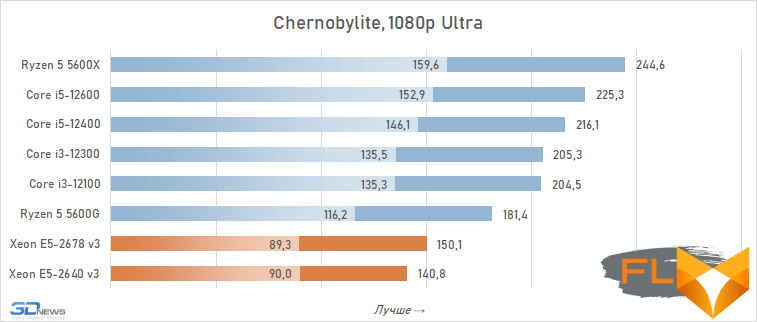
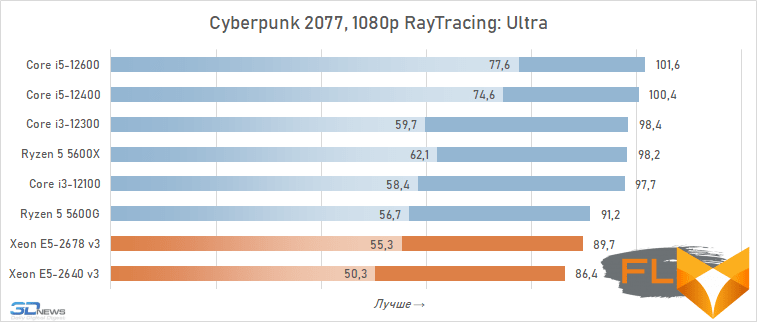
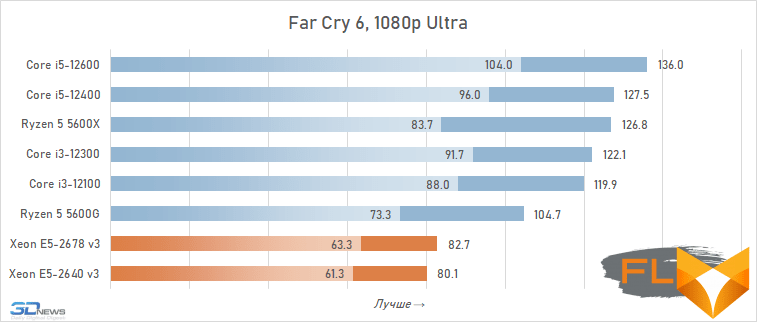
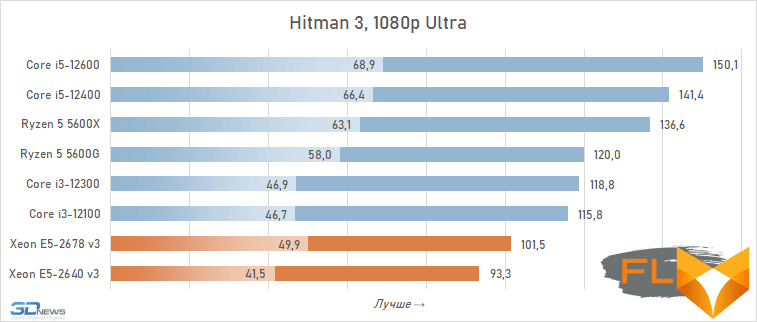
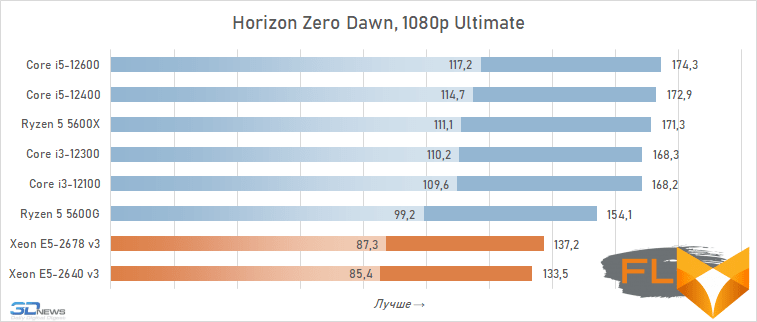
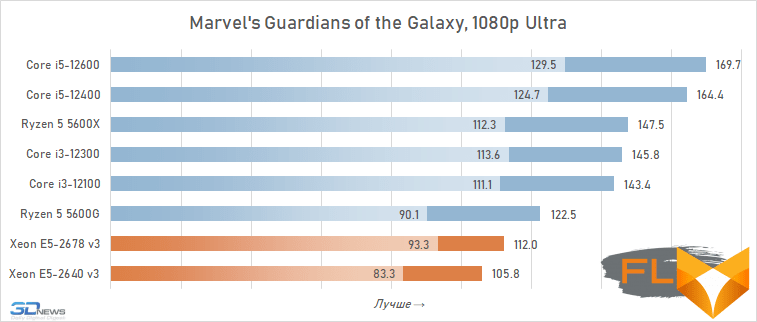
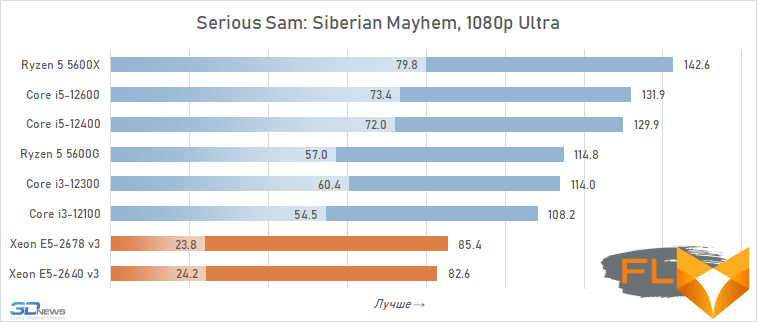


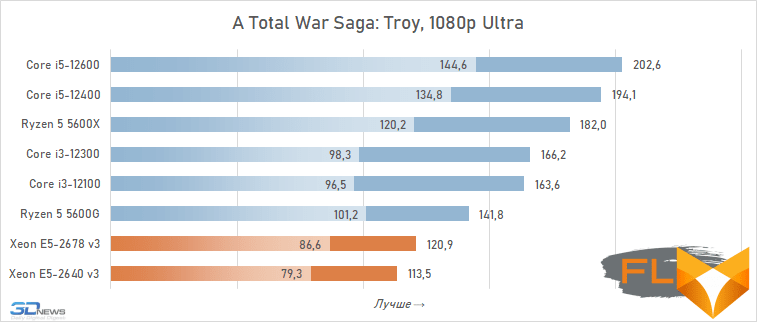
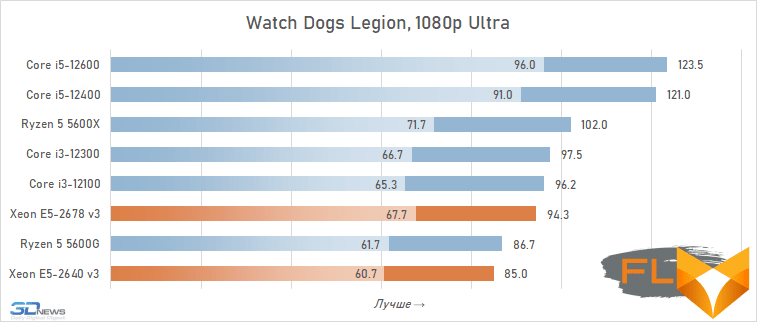
⇡#Energy Consumption
Power consumption Xeon E5 v3 in comparison with today’s chips is of particular interest. Still, we are talking about unusual multi-core solutions that were produced according to the 22 nm process technology, so it is important to make sure in practice that their appetites do not go beyond the reasonable.
Unfortunately, it is impossible to directly measure the consumption of old processors, since the sensor built into them gives a very large error. Therefore, for practical evaluation, we measured the total consumption of test systems (without a monitor) at the output of the power supply.
With a single-threaded load created by rendering in Cinebench R23, systems based on Xeon E5 v3 processors turn out to be more gluttonous compared to modern solutions. However, we are talking about a difference at the level of several watts, and it can be completely neglected.
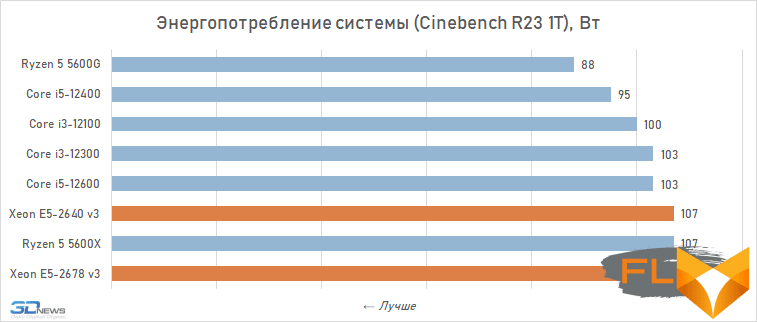
In the case of multi-threaded rendering, the picture changes somewhat. The octa-core Xeon E5-2640 v3 shows lower power consumption than some of today’s six-cores. However, it is impossible to say the same about the Xeon E5-2678 v3 – the 12-core processor consumes more than all other test participants. But it would be wrong to talk about some kind of “prohibitively high” appetite for this processor. If 12-core Core i7s were included in the comparison, the Xeon E5-2678 v3 would definitely not take the place of the anti-leader on the diagram.
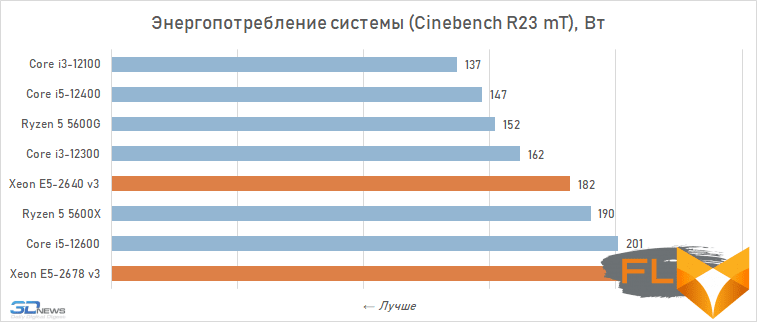
The same can be said about the power consumption in Prime95, where AVX2 instructions are heavily used. In general, the Xeon E5 v3 fits well into modern ideas about how much multi-core processors can consume. The only problem is that, consuming like flagships, they give performance at the level of budget solutions, that is, they lose miserably to actual chips in terms of specific energy efficiency.
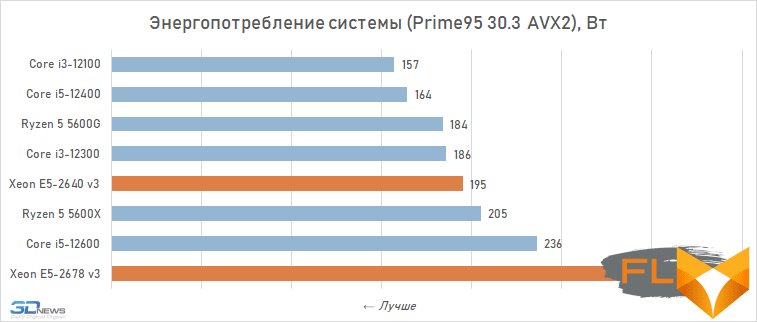
⇡#Conclusions
The Xeon cult with AliExpress arose far from this or even last year, but several years ago, and this is what gave it the opportunity to take shape. In 2022, the Xeon E5 v3 offered by the Chinese do not seem to be any interesting solutions at all, but when there was neither Zen 3, nor Alder Lake, nor Rocket Lake on the market, systems based on server processors from the early tenths may And there were some benefits. In the modern world, when both manufacturers of x86 processors are making significant efforts to intensify progress and increase performance, the old server processors look very, very faded.
As tests have shown, we can proceed from the fact that each pair of Xeon E5 v3 cores is comparable in multi-threaded performance to one Alder Lake or Zen 3 core. Thus, in parallelized loads, the eight-core Xeon E5-2640 v3 can only be compared with current Core class processors i3, and the 12-core Xeon E5-2678 v3 provides performance no better than the younger Core i5 and Ryzen 5.
At the same time, in the case of gaming or some other low-threaded loads, the performance of any Xeon E5 v3 against the background of modern chips looks frankly unsatisfactory. In terms of FPS in games, they lose about 20% to the junior quad-core Core i3-12100, and about 30% to the inexpensive six-core Core i5-12400.
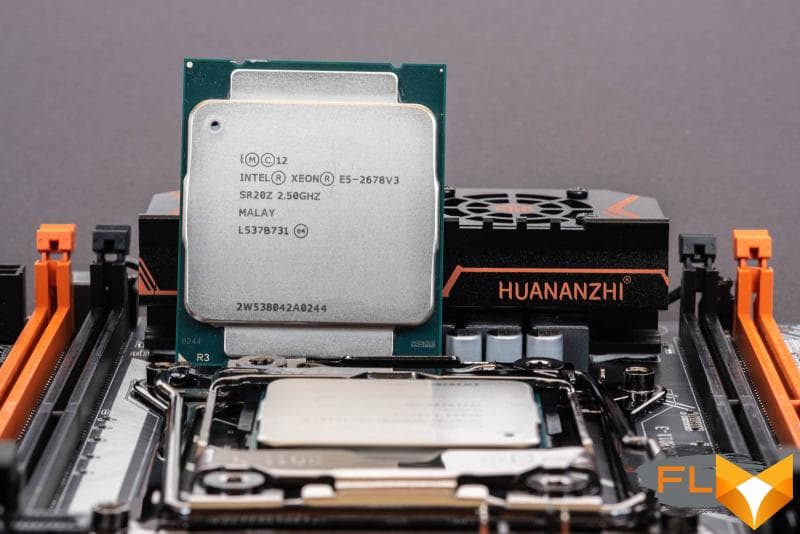
So, if there is a choice, systems on modern processors are a much more preferable option. However, Chinese merchants are well aware of this. That is why representatives of the Xeon E5 v3 family are sold on AliExpress cheaper than steamed turnips – prices for eight-core processors start at $15, and a 12-core processor with a low clock speed can be bought for $45. Actually, such prices are perfectly correlated with their real capabilities: modern processors, even entry-level ones, cost significantly more.
For this reason, the configurations built on the Xeon E5 v3 still have not completely lost their meaning. They are suitable for those who want to build the most affordable PC and do not make particularly serious demands on its performance. However, it must be understood that the Xeon E5 v3 will not allow you to “cheat the system” and get more by spending less. Ultimately, this is nothing more than a solution for ultra-budget assemblies, which is also aggravated by a bunch of shortcomings: the impossibility of upgrading, the “features” of Chinese motherboards, warranty problems, and so on. But it is very, very cheap.
FAQ Xeon e5-2640 v3 and xeon e5-2678 v3 aliexpress review
What are the specifications of the Intel Xeon E5 2678 V3 CPU?
The Intel Xeon E5 2678 V3 is a server-grade CPU that fits the LGA 2011-3 socket, offering multiple cores (up to 12), supports ECC memory, and is designed for heavy workloads and server environments.
Can I find the Intel Xeon E5 2678 V3 on platforms like AliExpress?
Yes, you can find the Intel Xeon E5 2678 V3 on AliExpress.com. Use the AliExpress Assistant to narrow down your search and find the best offers, possibly with buyer protection and free shipping options.
Is the Intel Xeon E5 2678 V3 considered good value for money?
The Intel Xeon E5 2678 V3 is often considered good value for money, especially when purchased from platforms like AliExpress or Alibaba, where it is available at a relatively low price for its performance capabilities.
What type of motherboard is compatible with the Xeon E5 2678 V3 CPU?
The Xeon E5 2678 V3 CPU is compatible with motherboards that have the LGA 2011-3 socket, such as those from the X99 motherboard series. Ensure the motherboard supports the Xeon V3 series for compatibility.
How can I ensure a good shopping experience when buying a Xeon E5 2678 V3 on AliExpress?
For a good shopping experience when buying a Xeon E5 2678 V3 on AliExpress, read real reviews, check the seller’s rating, and use the AliExpress Assistant to also filter out items that offer buyer protection and free shipping.
Are there special deals for CPUs like the Intel Xeon E5 2678 V3 during events like Black Friday on AliExpress?
Yes, during events like Black Friday, AliExpress often offers special deals on CPUs like the Intel Xeon E5 2678 V3, providing an opportunity to purchase at even lower prices.
What should I look for in a PSU when building a PC with an Intel Xeon E5 2678 V3?
When selecting a PSU for a PC with an Intel Xeon E5 2678 V3, ensure it provides sufficient power for your system, considering the Xeon’s power consumption and that of other components like the GPU.
Can the Intel Xeon E5 2678 V3 be used for gaming if paired with a good motherboard and GPU?
While the Intel Xeon E5 2678 V3 is primarily designed for server use, it can be used for gaming if paired with a good motherboard and a powerful GPU like an RX series card, though gaming performance may vary compared to mainstream gaming CPUs.
Are there any compatibility issues to be aware of when using the Xeon E5 2678 V3 with ECC memory?
When using the Xeon E5 2678 V3 with ECC memory, ensure that both the CPU and the motherboard support ECC, as this feature is crucial for error-checking in server environments and may not be supported by all motherboards.
To find related items or a CPU motherboard set for the Xeon E5 2678 V3 on AliExpress, use the search function, check the related searches section, and look at the ranking keywords to help you narrow down your options and find the best deals.
What makes a product great value on platforms like Alibaba or AliExpress?
A product is considered great value on platforms like Alibaba or AliExpress when it offers high quality and desirable features at a competitive price, often coupled with good customer reviews and reliable seller ratings.
How does the seller portal on Alibaba or AliExpress benefit sellers?
The seller portal on Alibaba or AliExpress provides sellers with tools to manage their products, track sales, communicate with customers, and access analytics to improve their online business performance.
What services does Alibaba Cloud offer to online shoppers and sellers?
Alibaba Cloud offers various services to online shoppers and sellers, including cloud storage, data analytics, and hosting services, enhancing the efficiency and security of online shopping platforms.
How do Alibaba International and Taobao Global differ in their offerings?
Alibaba International focuses on global trade between businesses, offering wholesale products, while Taobao Global targets individual consumers, offering a wide range of retail items and international shipping options.
What are Alimama and Alipay, and how do they support online shopping?
Alimama is Alibaba Group’s marketing technology platform, offering advertising and monetization services, while Alipay is a digital payment service that provides a secure and convenient way for transactions in online shopping.
What is Fliggy, and how does it relate to online shopping?
Fliggy, part of the Alibaba Group, is an online travel platform that allows users to book flights, hotels, and vacation packages, integrating travel services with Alibaba’s e-commerce ecosystem.
How do platforms like DingTalk and Juhuasuan enhance the online shopping experience?
DingTalk offers communication and collaboration tools for businesses, which can aid in efficient management of online stores, while Juhuasuan offers group buying deals and flash sales, enhancing the shopping experience with attractive offers.
What is the role of Tmall in the Alibaba Group website ecosystem?
Tmall is a premium online retail platform under Alibaba Group, hosting official stores of various brands, offering authentic products and catering to a higher-end consumer market.
What languages are supported on the Alibaba Group website for international users?
The Alibaba Group website supports multiple languages for international users, including English (??), Portuguese, Turkish, Thai, Vietnamese, Arabic, Hebrew, and others, to cater to a global audience.
How do items that offer free shipping impact online shopping decisions on platforms like Alibaba?
Items that offer free shipping are often more attractive to online shoppers on platforms like Alibaba, as they reduce the overall cost of purchase, making products more appealing and competitive.



